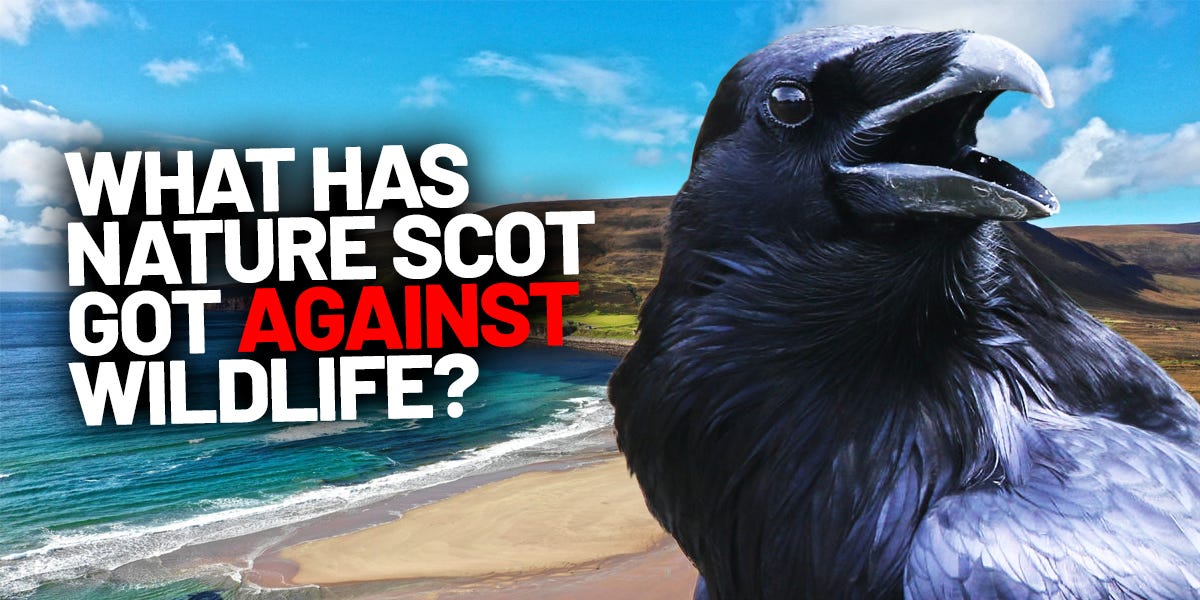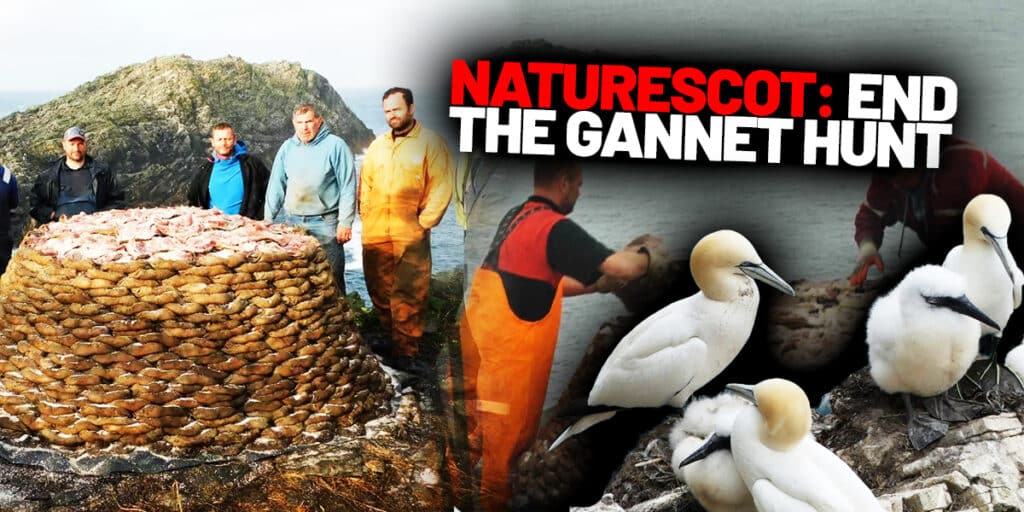To widespread condemnation, NatureScot – Scotland’s nature agency that (supposedly) works “to improve our natural environment in Scotland and inspire everyone to care more about it” – has once again licensed the killing of young, pre-fledged Northern Gannets – known locally as ‘guga’ – on Sula Sgeir, a remote and uninhabited island north of the Isle of Lewis.
The ‘guga hunt’, Scotland’s last surviving legal slaughter of seabird chicks, takes place in August and usually lasts for around two weeks. Ten people, known as the Men of Ness, kill the young gannets after catching them on the cliffs using a pole and noose.
NatureScot has given the men permission to kill up to 500 Gannet chicks after a three-year break imposed due to the visible impact of Avian Influenza, which has ravaged populations of the species worldwide in recent years.
Scotland’s important Northern Gannets
Population counts of seabird colonies aren’t made every year but surveys have suggested that Scotland is home to a significant portion of the global Northern Gannet population, with some estimates placing it at almost half the world’s population. However, Northern Gannets have been seriously impacted by Avian Flu. In 2022, Avian flu hit seabird colonies in the Western Isles and the remote St Kilda archipelago, with gannets among the species worst affected. RSPB Scotland suggested earlier this year that gannet numbers had declined by 22%.
Prior to the ravages of Avian Flu, the Northern Gannet was already classified in the UK as Amber under the Birds of Conservation Concern 5: the Red List for Birds (2021).

NatureScot, the organisation behind the licence being granted, explained that the number of kills allowed had been reduced from the 2,000 previously permitted to 500 to “help the gannet population recover from the ravages of bird flu”.
A NatureScot spokesperson said:
“We have thoroughly assessed the application taking into account survey data and population analysis and we have granted a licence with a limit of 500 birds. This revised limit for 2025 safeguards the sustainability of the Sula Sgeir gannet population and allows for its continued recovery following avian flu.”
This is the very same NatureScot (then called Scottish Natural Heritage), though, that wrote in 2016 in “Population viability analysis of the Sula Sgeir gannet population” that Sula Sgeir’s gannet population was growing at a slower rate than other colonies and that overall growth was only bolstered by immigration from neighbouring colonies. It explicitly warned:
“It appears from the modelling presented that the harvest of gannet chicks at Sula Sgeir has reduced the rate of population growth rate below the level that would be predicted in the absence of harvest. It is also likely that this has had an effect (to a smaller extent) on other populations that are linked through immigration and emigration.”
While the report says that despite what is euphemistically called ‘harvesting’ the gannet population has continued to grow, this was written a decade ago and doesn’t take into account recent losses to avian flu or the increasing impacts of warming seas and overfishing (gannets typically feed on schooling fish like mackerel, herring, and sand eels all of which are in long term decline, with the UK taking the unusual step of banning industrial sand eel fishing in its waters in 2024).
It is also the very same NatureScot that published an article about The Scottish Marine Environmental Enhancement Fund (SMEEF) in May 2025. The article said that the SMEEF was “excited to announce” a new Seabird Resilience Fund to help “safeguard the future of Scotland’s precious seabirds”. A £1.6m investment, funded by voluntary donations from a group of offshore renewable energy developers, aimed to fund practical projects “to protect seabirds from the many threats they face”, both at sea and on land.
The article noted specifically that Scotland’s seabirds were under pressure from a range of factors including climate change, invasive species and food availability, and that seabird numbers had fallen dramatically between 1986 and 2023. The number of birds on Scotland’s coastal breeding grounds is now nearly half of what it was in 1986.
It went on to say
“Thriving populations of seabirds are not only important for Scotland but globally. Twenty-four species have their regular breeding grounds here, approximately 60% of the world’s breeding population of great skua, 46% of the world’s northern gannet and 16% of the world’s Manx shearwater. This unique fund has the chance to support recovery and resilience that can contribute to global conservation goals.”
NatureScot – remember – published that article less than three months ago…

NatureScot has a history of licencing killing
It’s a sad fact that NatureScot/Scottish Natural Heritage has a long history of doling out licences to kill wildlife.
In 2019 The Ferret revealed that “since 2014 Scottish Natural Heritage has issued almost 4,000 licences to farmers, landowners and others to kill 97,500 geese, 11,400 hares, 10,000 gannets and 6,000 ravens. Hundreds of goosanders, cormorants, jackdaws, starlings, gulls, magpies and pigeons were also allowed to be killed.”
Campaigner Jason Endfield reported on his ‘Observations from a life in progress’ blog back in 2023, that NatureScot had issued licences to kill 3307 Ravens, 6507 Brown Hares, 4996 Mountain Hares, 6000 Gannets, 9448 Greylag Geese, and 4809 Barnacle Geese since 2019.
As we wrote just two months ago in “Ravens: NatureScot bends rules for sheep farmers again”, NatureScot was drawing up new powers to ‘cull’ – shoot dead – young Ravens in Orkney. To pacify animal farmers on the islands, it presented evidence at a meeting that it had granted 34 licences to ‘control’ Ravens on the islands since 2016 covering 28 locations. This had resulted in 124 being killed.
For an agency responsible for the country’s “natural, genetic and scenic diversity”, NatureScot appears to be far too trigger-happy…
Bloody tradition
Defenders of this appalling raid on increasingly fragile seabird colonies claim it is ‘tradition’ and that it is “no more cruel than other similar activities such as grouse shooting”!
‘Tradition’ is the same shameful excuse used by Spain for allowing the obscenity of bull fighting and by the Faroe Islands to allow the disgusting slaughter of Pilot Whales in the grindadráp. It is the same feeble excuse used by shooters across Europe to continue killing Turtle Doves in huge numbers, to ignore the ban on the trapping of migrating birds on Cyprus (for a snack known there as ambelopoulia), and of course for fox hunts to continue here in England.
There is zero ‘need’ in 2025 to rip young birds from their parents, and ‘tradition’ is never a valid excuse for abusing, exploiting, or killing sentient animals. To excuse this dishonourable and archaic slaughter by saying it’s no more cruel than putting lead into the bodies of living Red Grouse reveals a mentality that belongs in the distant past. To have this unnecessary and barbaric ‘hunt’ supported by a government agency is unforgivable.
The new CEO of Scottish charity OneKind, Jason Rose, put it well when he said
“Snatching wild baby birds from their nests and bashing their heads in, using the excuse of tradition, will appal and embarrass most people in the Western Isles and across Scotland…the guga hunt is a grisly story from history that should be left in books or a museum.”

NatureScot must reverse this awful decision
NatureScot is attempting to justify the ‘hunt’ as ‘sustainable’ (the same weaselly word, incidentally, used by the Labour government to justify the killing of millions of pheasants, partridges, grouse, and mallards every year). It is most definitely not ‘sustainable’ for the poor birds being killed, and it’s hard to see how allowing the pointless killing of any bird species under so much pressure in the wild can ever be considered ‘sustainable’.
And it’s impossible to understand how killing young gannets will improve the “natural environment in Scotland” or “inspire everyone to care more about it”.
We have created a petition calling on NatureScot to immediately revoke the licence granted for the killing of 500 young gannets (guga) on Sula Sgeir and to take urgent steps to ensure that this outdated and inhumane practice is brought to a permanent end.
- Please sign “Revoke the Licence to Kill Gannets on Sula Sgeir” now and share the petition

